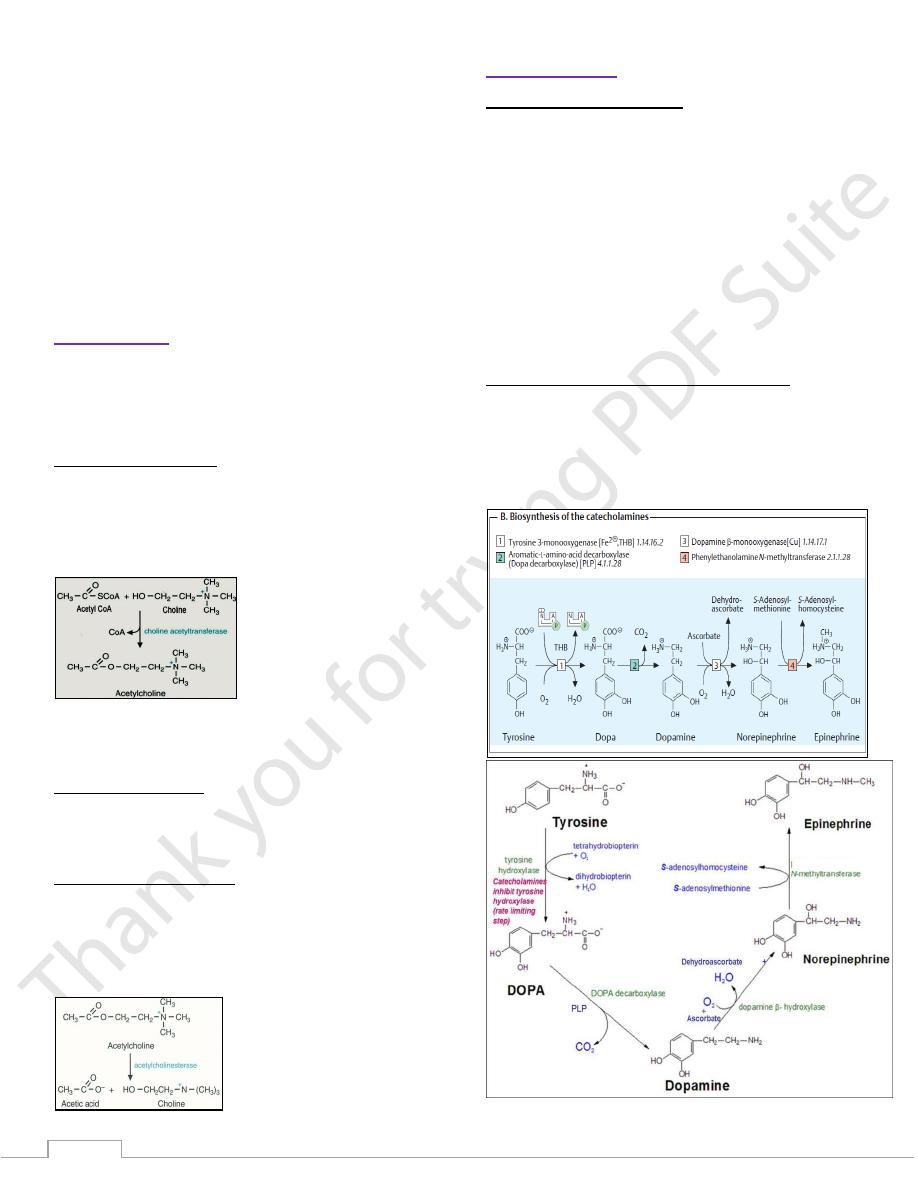
10
Lecture 5 - Neurotransmitters
Are substances produced by neurons, stored in the synapses
and released into the synaptic cleft in response to a stimulus.
At the postsynaptic membrane, they bind to special receptors
and affect their activity.
Neurons communicate neurons in circuits
Action potentials (AP) carry electrical signals down the
axon
Chemicals (neurotransmitters; NT) are released when the
AP signal arrives at the synapse
The NT causes an new electrical signal in the other neuron
Acetylcholine
Ach is the major neurotransmitter at neuromuscular junctions.
It acts at neuromuscular junctions, where it triggers muscle
contraction.
Transmits impulses in the autonomous nervous system.
Synthesis of acetylcholine
Acetylcholine is synthesized from: Acetyl CoA & choline by
the enzyme Choline Acetyltransferase in the Presynaptic
terminal.
Ach is stored in vesicles & later released through calcium-
mediated exocytosis.
The Acetyl group is derived mainly from:
Glucose oxidation to pyruvate and decarboxylation of
pyruvate to form Acetyl CoA by pyruvate dehydrogenase
Sources of Choline are:
Choline is a common component of the diet
Hydrolysis of Ach by Acetylcholinesterase
Hydrolysis of membrane phosphatidylcholine
Inactivation of acetylcholine
The action of Ach is terminated in the synaptic cleft.
Ach is hydrolyzed by acetylcholinesterase located on the outer
aspects of both pre- & postsynaptic membranes.
Acetylcholinesterase, is inhibited by many drugs and
neurotoxins.
Catecholamines
Biosynthesis of catecholamines
The catecholamines are amines that have a catechol group.
Their biosynthesis in the adrenal medulla and CNS starts from
tyrosine:
1) Hydroxylation of the aromatic ring initially produces dopa
(3, 4-dihydroxyphenylalanine).
2) Decarboxylation of dopa yields dopamine, an important
transmitter in the CNS.
3) The Adrenal Gland And Adrenergic Neurons Continue The
Synthesis By Hydroxylating Dopamine Into
Norepinephrine (Noradrenaline).
4) Finally, N- Methylation Of Norepinephrine Yields
Epinephrine (Adrenaline).
The Physiological effects of The catecholamines are
mediated by a large number of different receptors that are of
particular interest in pharmacology.
Norepinephrine acts in the autonomic nervous system and
certain areas of the brain. Epinephrine is also used as a
transmitter by some neurons.

11
Medullary release of catecholamines
Stimulation of the sympathetic NS increases medullary release
of catecholamines and their rate of synthesis because the
enhanced tyrosine hydroxylase activity.
Thus, the adrenal medulla stores will not fall dawn even under
prolonged stimulation.
Enzymes controlling biosynthesis of catecholamines are
present in the adrenal medulla and in the peripheral
sympathetic nerves.
Catabolism of catecholamines
These hormones are rabidly inactivated after their release in
their active sites by different mechanisms including:
methylation and oxidative deamination catalyzed by the
enzyme monoaminoxidase.
The liver is also a major site of these enzymes and the last
metabolites are excreted in urine.
Clinical importance of catecholamines
Inhibitors of the aromatic AA decarboxylase have been used
in the therapeutic medication for the treatment of different
pathologies, which happen due to increased catecholamines
activity.
The alpha methyldopa: is used as a false neurotransmitter in
treatment of hypertension.
This false neurotransmitter is less active than the normal
catecholamine, and when released will have only a miner
transmission effects thus reducing the stimuli on the heart and
small arteries leading to vasodilatation and decreases blood
pressure.
L-dopa:
Is used in the treatment of Parkinson's disease, which is a
chronic nervous system disease due to reduction in the
neurotransmitter dopamine in the central nervous system in
the old age group.
Patients with this disease have: fine tremor in the hands
and feet, slow speech and muscular rigidity.
L-dopa is transformed at the CNS to dopamine and thus
refreshes & stores of the low levels of the neurotransmitter.
Inherited abnormalities of AA transport
mechanisms
Groups of chemically similar amino acids are reabsorbed in
the renal tubule by shared mechanisms. In several cases,
similar mechanisms are involved in the intestinal absorption.
So defects could involve both renal tubular function and
intestinal mucosa.
Four main group pathways:
1) The dibasic amino acids: cystine, ornithine, and lysine.
Abnormal metabolism leads to cystinuria.
2) The neutral amino acid: tryptophan
Abnormality leads to hartnup disease.
3) The imino acids: proline, hydroxyproline, & glycine leads to
familial iminoglycinuria.
4) The branched-chain amino acids: (leucine, isoleucine &
valine). Leads to maple syrup urine disease.
Cystinuria
Is due to inherited abnormality of tubular reabsorption of the
dibasic amino acids: cystine, ornithine, and lysine; results in:
excessive urinary excretion of these amino acids due to failure
of renal tubular reabsorption. Because cystine is less soluble, it
may form stones in the urinary tract.
Diagnosis: is by the demonstration of cystine in urine.
The condition is generally harmless except for stone formation
So treatment aims to decrease cystine stone formation by
advising the patient to take fluids to increase the solubility of
cystine.
Hartnup disease
Is a rare disease in which there is a renal and intestinal
transport defect involving absorption and increased urinary
loss of the tryptophan.
This amino acid is normally converted to nicotinamide. if the
patient is also have a low nicotinamide in take, then the
clinical picture of hartnup disease will appear which are
resembling those of pellagra due to niacin (nicotinamide)
deficiency.
Signs and symptoms
Red scaly rash on the exposed skin.
Abnormalities and inflammation of tong and mouth.
Weakness and anemia.
Involvement of the CNS with loss of memory &confusion.
GIT disturbance and diarrhea.
Maple syrup urine disease
In this disease there is:
Deficient decarboxylation of the oxoacids resulting from
the deamination of the three branched-chain amino acid
(leucine, isoleucine and valine).
These AAs will accumulate in the blood and are excreted
in urine together with their corresponding oxoacids .
The odor of the urine resembles that of maple syrup ,gives
the disease its name.
The disease presents in the first few weeks of life and if not
treated, sever neurological lesions develop with death in a few
weeks or months.
If the disease is diagnosed early and these amino acid removed
from diet, normal development seems possible.
Diagnosis: In suspected case, examination of urine sample for
these amino acid will lead to diagnosis.
